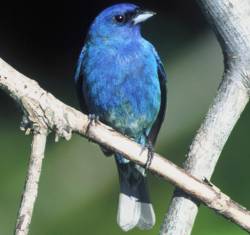Indigo Bunting
|
|
| Indigo Bunting | ||||||||||||||
|---|---|---|---|---|---|---|---|---|---|---|---|---|---|---|
 | ||||||||||||||
| Scientific classification | ||||||||||||||
| ||||||||||||||
| Binomial name | ||||||||||||||
| Passerina cyanea (Linnaeus,, 1766) |
The Indigo Bunting, Passerina cyanea, is a small seed-eating bird in the family Cardinalidae.
Adult males have deep blue plumage; the wing and tail are black with blue edges. Adult females are brown: darker on the upperparts, faintly streaked underneath.
Their breeding habitat is brushy edges across eastern North America and the southwest United States. They nest relatively low in dense shrub or a low tree. These birds are monogamous but not always faithful to their partner. In the western part of their range, they often hybridize with the Lazuli Bunting.
They migrate to southern Mexico, the West Indies and Central America. They occur in western Europe as an extremely rare vagrant.
These birds forage on the ground or in trees or shrubs. They mainly eat insects and seeds. In winter, they often feed in flocks.
The song of this bird is a high-pitched buzzed sweet-sweet chew-chew sweet-sweet.
See also
The Indigo Bunting will migrate during the night, using the stars to direct itself. In captivity, since they cannot migrate, they experience disorientation in April/ May and in September/ October if they cannot see the stars from their enclosure.
